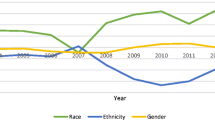Abstract
In this paper, we examine the effect of the 1999 North Carolina predatory lending law on mortgage activity in that state as compared to other states in the Southeastern United States. Using 1998–2000 Home Mortgage Disclosure Act (HMDA) data, we find that the North Carolina law reduced the overall level of subprime mortgage lending activity. Furthermore, we find that the North Carolina decline was caused by a decline in loan application volume and not by a change in loan denial rates, suggesting less aggressive marketing in that state after the imposition of the law. Finally, the impact of the legislation was different by both the type of financial service provider and borrower. Specifically, non-bank subprime lending contracted faster in North Carolina when compared to the control group, while both minority and low-income applicants were also less likely to get loans following the legislation. These results have wide ranging policy implications given that several predatory lending proposals are currently before Congress, as well as proposed in almost forty other states.
Similar content being viewed by others
References
Andrukonis, D. A. (2000). “Letters: Freddie Mac Defends Purchases of Subprime Mortgages,” American Banker (April 6), 7.
Anonymous. (2001). “Agencies Expand Subprime Lending Guidance,” ABA Bank Compliance 22(3), 5.
Anonymous. (2002a). “Three States Pass Anti-Predatory Lending Legislation,” Journal of Housing and Community Development 59(1), 9.
Anonymous. (2002b). “Department of Justice May Target Lenders with High Foreclosure Rates,” National Mortgage News (May 13), 23.
Association of Community Organizations for Reform Now (ACORN). (2001). Separate and Unequal: Predatory Lending in America. Washington, D.C: ACORN (November).
Barancik, S. (1999). “FDIC Chief Urges Tighter Capital Rules on Subprimes,” American Banker (October 12), 1.
Bergquist, E. (2001). “N.C. Passes 2d Predator Law,” American Banker (September 21), 6.
Bergquist, E. (2002). “Sarbanes Aide: Best Practices Not Good Enough,” American Banker (June 12), 11.
Bradford, C. (2002). “Risk or Race? Racial Disparities and the Subprime Mortgage Market,” Report Issued by the Center for Community Change.
Calem, P., and S. M. Wachter. (1999). “Performance of Mortgages in a Community Reinvestment Portfolio,” Real Estate Economics 28(3), 385-404.
Canner, G., W. Passmore, and E. Laderman. (1999). “The Role of Specialized Lenders in Extending Mortgages to Lower-Income and Minority Homebuyers,” Federal Reserve Bulletin (November), 709-726.
Collins, B. (2002). “Fed Regulatory Change Expands HOEPA's Reach,” Origination News (January), 1.
Cornwell, T. (2002). “Subprime Lending Forecast: Defaults Will Edge Up on New Production,” National Mortgage News (June 17), 14.
Duran, N. (2002). “In Brief: Preemption Talk Raises Subprime Hopes,” American Banker (May 6), 24.
Engel, K., and P. McCoy. (2001). “The Law and Economics of Remedies of Predatory Lending,” Proceedings of a Federal Reserve System Community Affairs Research Conference: Changing Financial Markets and Community Development (April 5–6).
Ernst, K., J. Farris, and E. Stein. (2002). North Carolina's Subprime Home Loan Market after Predatory Lending Reform. Durham, N.C.: Center for Responsible Lending.
Federal Reserve Board. (2002). “Remarks by Federal Reserve Board Governor Edward M. Gramlich at the Housing Bureau for Seniors Conference, Ann Arbor, Michigan,” (January 18). Available at www.federalreserve.gov/boarddocs/speeches/2002/20020118/default.htm.
Federal Trade Commission. (1998). “Relevant Statutes Enforced by the Federal Trade Commission,” FTC FactSheet, (January 30), 1998.
Immergluck, D. (1999). Two Steps Back: The Dual Mortgage Market, Predatory Lending, and the Undoing of Community Development. Chicago: The Woodstock Institute.
Kuykendall, L. (2001). “Providian Ordered Out of Subprime,” American Banker (November 29), 1.
Lax, H., M. Manti, P. Raca, and P. Zorn. (2000). “Subprime Lending: An Investigation of Economic Efficiency,” Working paper, Freddie Mac.
Marsico, R. (2001). “Patterns of Lending to Low-Income and Minority Persons and Neighborhoods: The 1999 New York Metropolitan Area Lending Scorecard,” New York Law School, Public Law Research Paper No. 02/02.
Nathan, L. (1999). “Borrower Beware: Equity Strippers are Preying on Elderly Homeowners,” Communities and Banking (Spring).
Office of the Comptroller of the Currency (OCC), Federal Deposit Insurance Corporation (FDIC), Federal Reserve Board (FRB), and Office of Thrift Supervision (OTS). (2001). “Expanded Guidance for Subprime Lending Programs,” OCC Bulletin (2001-6).
Scheessele, R. M. (1999). “1998 HMDA Highlights,” Working Paper No. HF-009, Office of Policy Development and Research, U.S. Department of Housing and Urban Development.
Schieber, P. H., and H. Disque. (2002). “Prey Tell... Predatory Lending Update,” The RMA Journal (April), 34-36.
Staten, M. E., and G. Elliehausen. (2001). “The Impact of the Federal Reserve Board's Proposed Revisions to HOEPA on the Number and Characteristics of HOEPA Loans,” Credit Research Center Working Paper #61. Washington, D.C.: McDonough School of Business, Georgetown University.
Stein, E. (2001). Quantifying the Economic Cost of Predatory Lending. Durham, N.C.: Center for Responsible Lending.
U.S. Department of Housing and Urban Development. (2000). Unequal Burden in Atlanta: Income and Racial Disparities in Subprime Lending. Washington, D.C.
U.S. Department of Housing and Urban Development. (2000). Unequal Burden in Baltimore: Income and Racial Disparities in Subprime Lending. Washington, D.C.
U.S. Department of Housing and Urban Development. (2000). Unequal Burden in Los Angeles: Income and Racial Disparities in Subprime Lending. Washington, D.C.
U.S. Department of Housing and Urban Development. (2000). Unequal Burden in New York: Income and Racial Disparties in Subprime Lending. Washington, D.C.
U.S. Department of Housing and Urban Development (HUD) and U.S. Department of the Treausry (Treasury). (2000). “Curbing Predatory Home Mortgage Lending: A Joint Report,” United States Department of the Treasury and United States Department of Housing and Urban Development.
Vermilyea, Todd, and James Wilcox. (2002). “Who is Unbanked, and Why: Results from a Large, New Survey of Low-and-Moderate Income Adults,” Paper prepared for the Federal Reserve Bank of Chicago's 38th Annual Conference on Bank Structure and Competition (May 8–10).
Author information
Authors and Affiliations
Rights and permissions
About this article
Cite this article
Harvey, K.D., Nigro, P.J. Do Predatory Lending Laws Influence Mortgage Lending? An Analysis of the North Carolina Predatory Lending Law. The Journal of Real Estate Finance and Economics 29, 435–456 (2004). https://doi.org/10.1023/B:REAL.0000044022.66852.40
Issue Date:
DOI: https://doi.org/10.1023/B:REAL.0000044022.66852.40




